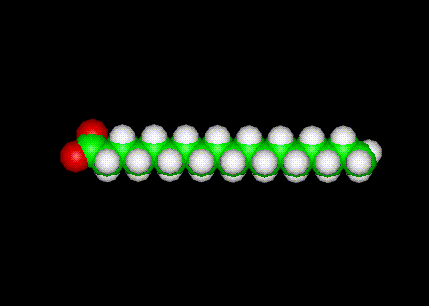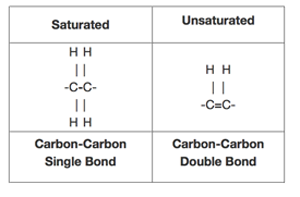Stearic Acid

The lipid shown here is Stearic Acid in a ball-and-stick configuration.
Stearic Acid is a saturated fatty acid.
- Stearic Acid - CH3(CH2)16COOH - (C:D = 18:0)

The structure of saturated and unsaturated chemical bonds looks like the diagram below.

Saturated fatty acids are of the form R-COOH
where R = CH 3-(CH2)n - n being any integer greater than or equal to 1In chemistry, especially biochemistry, a fatty acid is a carboxylic acid (or organic acid), often with a long aliphatic tail (long chains), either saturated or unsaturated. Most of the natural fatty acids have an even number of carbon atoms, because they are made up of acetate which has two carbon atoms.
Stearic acid also called octadecanoic acid CH3(CH2)16COOH is one of the many useful types of saturated fatty acids that comes from many animal and vegetable fats and oils. It is a waxy solid that melts at around 70°C and its chemical formula is . Its name comes from the Greek word, stear, which means tallow.
Stearic acid is prepared by treating animal fat with water at a high pressure and temperature. It can also be obtained from the hydrogenation of vegetable oils. Stearic acid is useful as an ingredient in making candles, soaps, and cosmetics and for softening rubber.
Stearic acid is noteworthy as the most common saturated fatty acid, another common one being the C16 compound palmitic acid.
Stearic Acid in Health
Even though stearic acid it is a saturated fat, studies have suggested that it has little effect on blood cholesterol levels, because such a high proportion is converted to oleic acid. Stearic acid is found in chocolate and cocoa.
From Technical Summary on Stearic Acid from Beefresearch.com
"...Stearic acid (systematic name, octadecanoic acid, CH3(CH2)16COOH) is a long-chain fatty acid consisting of 18 carbon atoms without double bonds. Although it is classified as a saturated fatty acid (SFA), both biochemically and for purposes of nutrition labeling and dietary recommendations, data accumulated during the past 50 years indicate that stearic acid (C18:0) is unique among the SFAs in the food supply.1-4 Unlike other predominant long-chain SFAs – palmitic (C16:0), myristic (C14:0), and lauric (C12:0) acids -which increase blood cholesterol levels - stearic acid has been shown to have a neutral effect on blood total and low-density-lipoprotein (LDL) cholesterol levels.1-5 Stearic acid's neutral effect on blood total and LDL cholesterol levels implies that this longchain SFA may not increase the risk for cardiovascular disease. For this reason, it has been suggested that stearic acid not be grouped with other long-chain SFAs, although to date this recommendation has not been implemented in dietary guidance or nutrition labeling..."
Major food sources of stearic acid for adults are meat/ poultry/fish, grain products, and milk/milk products (Table 1). Fats rich in stearic acid include cocoa butter (typically consumed as chocolate), mutton tallow, beef tallow, lard, and butter.1,7 In meat (beef, pork, lamb, veal), stearic acid ranges from approximately 9% to 16% of total fat (Table 2). In lean ground beef (95% lean, 5% fat), stearic acid makes up 16% of total fat. A skinless, roasted chicken breast contains less stearic acid, with levels approximating 8% of total fat (Table 2).
Fats in Cooking and Health
- What are the differrent types of fatty acids?
- What are Trans Fats?
- What is the difference between LDL and HDL?
- What are the different types of omega 3 fatty acid?
- What are omega-6 fatty acids?
- What are omega-6 fatty acids?
- The importance of the ratio of omega-6/omega-3 essential fatty acids
- What is the difference between saturated and unsaturated fats?
- What causes oils to go rancid?
- What are essential fatty acids?
- Duck Fat as an alternative to butter
- How to render duck fat
- Did butter get a bad rap?
Types of Fatty Acids
Saturated